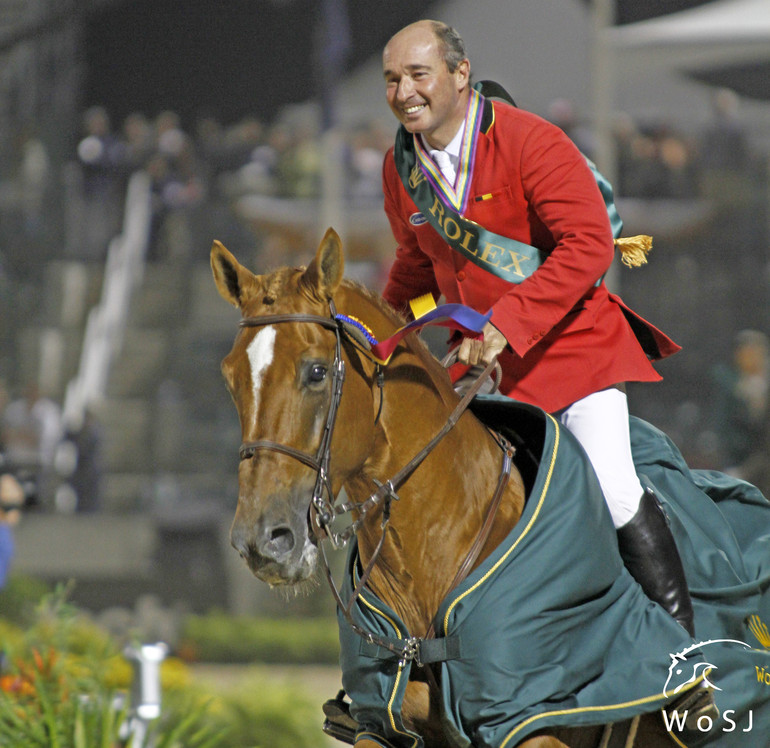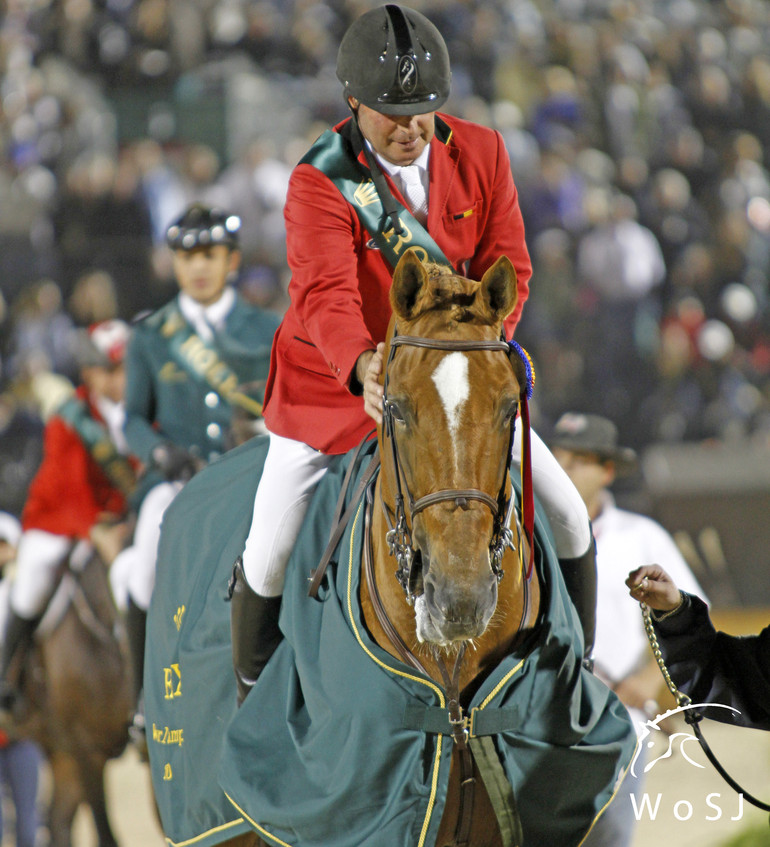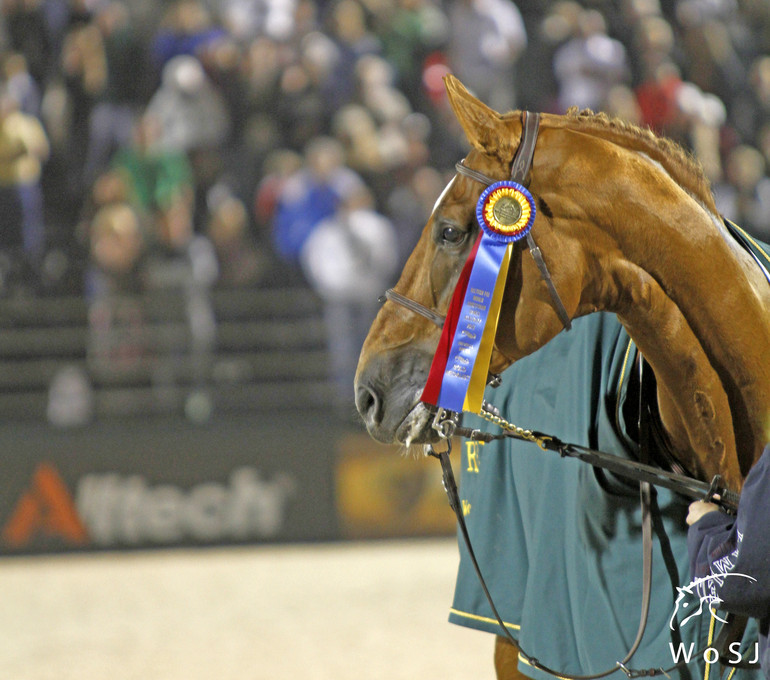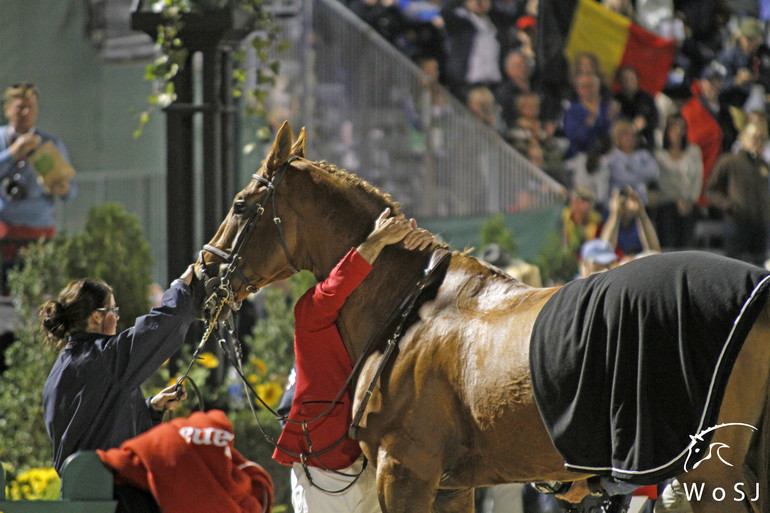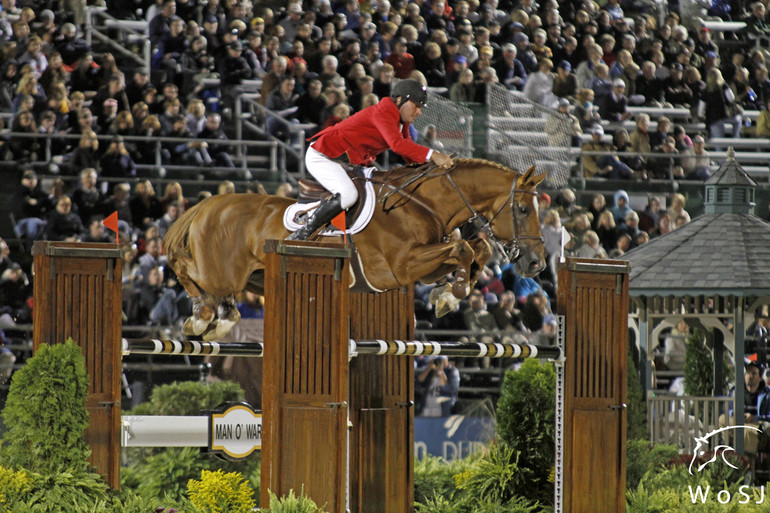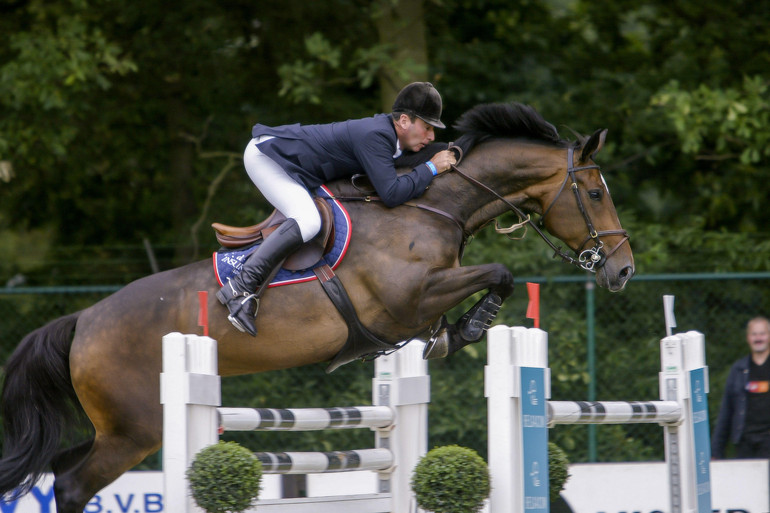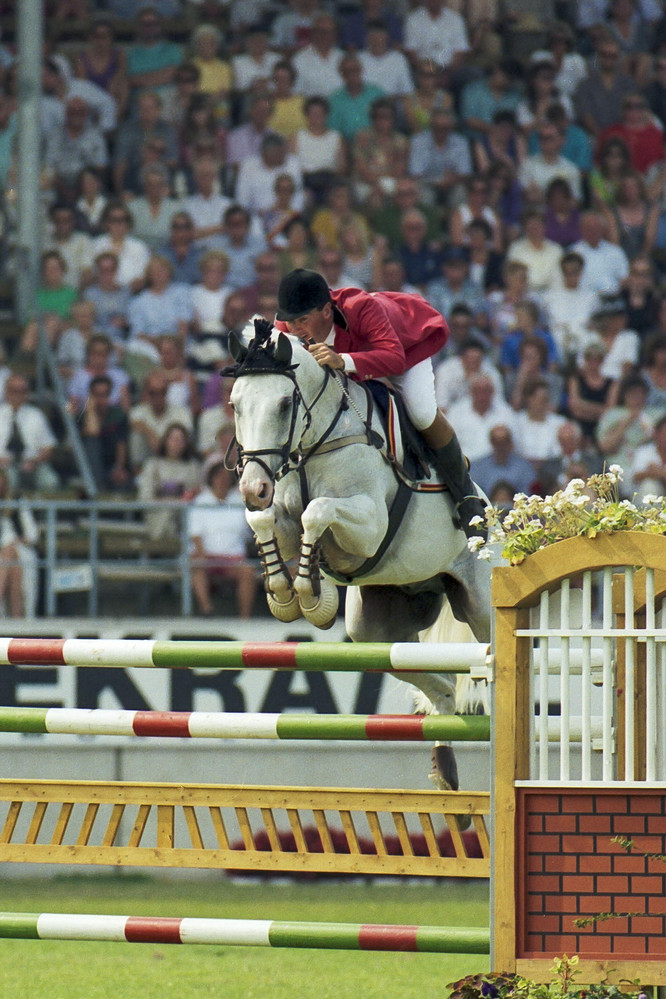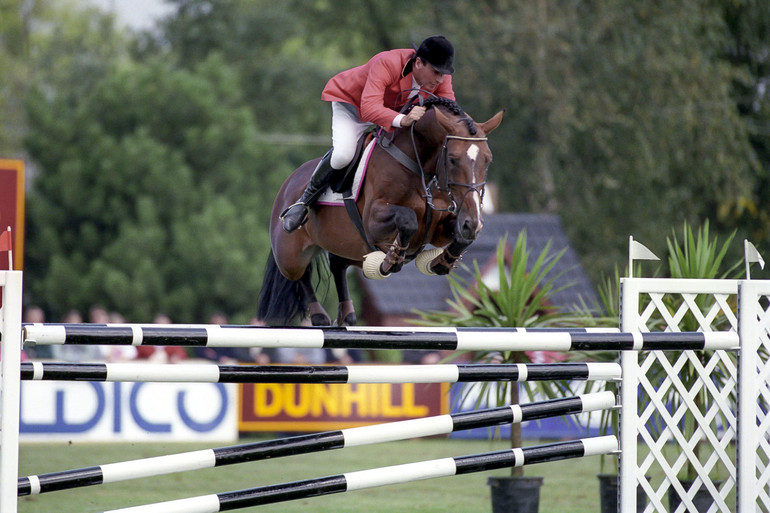In our series ‘That Special Bond’, we highlight what this sport truly is about; the unique connection between horses and humans. Speaking with some of the top names in the sport, we learn more about the horses that have shaped careers, fulfilled dreams – and sometimes even broken hearts. This time around, it’s 2010 World Champion Philippe Le Jeune who looks back at his career and the incredible horses that have been part of it.
“I have had some unbelievable horses throughout my career, but Vigo d’Arsouilles (Nabab de Reve x Fleuri du Manoir) – that I became World Champion with in 2010 in Kentucky – was like no one else,” Le Jeune says. “Vigo was a special horse in many ways, and I learned so much from him – he made me a better horseman. Vigo knew how much I loved him, and he would do anything for me.”
The special one
“The horses that came to me were usually at the age of 6 or 7, did not cost a lot of money, and were never well-known. From there, I brought them up to Grand Prix level – it’s how I always did it,” Le Jeune begins. “One of these horses was Nabab de Reve, and the story with Vigo began with him. At the time I got Nabab, he was jumping in national 1.40m classes with another Belgian rider. He was not really exceptional, and not the easiest either.
Through a mutual friend of Joris De Brabander and myself, my name came up and it was suggested that I would be the right rider for Nabab. Joris and I got in contact, and I got to meet Nabab. At the time, his rideability was not that great, he did not have a good gallop, he had a special mouth – all over, he was a lot of work. However, Nabab was brave, honest and had all the scope in the world with a nice technique.”
“After a year or so, I was in doubt if I would make it with him. I was thinking he was too difficult,” Le Jeune tells. “But, with the help of Nelson Pessoa – that I was training with at the time – I slowly managed to make adjustments that improved Nabab. To make it short, Nabab went on to take the team bronze medal at the World Equestrian Games in Jerez in 2002, and he also won some nice classes as well as jumping many clear Nations Cup rounds for Belgium.”
“When Nabab went back to Stal de Muze to focus on his breeding career, Joris told me that he thought he had my next championship horse – a horse that one day would jump the Grand Prix of Aachen,” Le Jeune tells. “When Vigo was at the end of his 7th year, Joris asked me to come and see him. There he was; a big chestnut, a bit difficult to ride, but he had already won the 6-year-old cycle in Belgium with only clear rounds. Vigo had a long gallop, with a really big stride, and did not particularly want to do the flying changes – so the one thing I always had to focus on was that his gallop was in balance. However, he had an unbelievable will to work, was really intelligent and so careful. While he was slow, he had a lot of blood, I always had to hold him off, but never push.”
“Vigo turned out to be a really special character. At home, he was extremely dominant with other horses,” Le Jeune tells. “Sometimes he could even be really aggressive, and also very jealous. There were horses that you could not pass by his box with; he would attack, kick and hurt himself. I lost count of how many times we found him with cuts and scratches. At the time, I had a small speed horse called Leo du Prairial, and he and Vigo were best friends – you could have put them in the same box. On the other hand, I had Querlybet Hero, and I could not even pass by Vigo’s box with him or have the two ridden at the same time in one ring because Vigo would go after him. Vigo would upset himself so much that he sometimes would not eat, ending up causing himself stomach problems and so on.”
“On top, he was completely crazy in the field. He would run like a wild horse, ears flat back, until he nearly killed himself. As all my horses go out every day, I tried again and again, but he would just run like hell, ending up getting injured,” Le Jeune tells. “Once, when we tried to catch him, he would not let us. We were five people, with buckets of food, but still we could not get to him. In the end, I had to get a mare out that was in heat and finally he came over so I could get a hold of him. On the other hand, I could take him on the lunge line for grass, sit down to read the newspaper and he would eat peacefully next to me and not move a centimetre. He was also horrible on the truck, and to clip him was dangerous. I was the only one to clip him in the beginning. I remember that we had a professional clipper coming in, but even when tranquilised, Vigo would be impossible. Eventually, one of the girls who worked for us – Melanie – managed; she was talking to him, telling him stories, and he would let himself clip by her. For two years, as long as it was Melanie clipping him, he did not need anything to calm him.”
“Once you put the saddle on him though, Vigo would do anything – he would kill himself for his rider,” Le Jeune says. “He always tried his heart out for me when I rode him, but to manage him was terrible.”
“Because I had to do things his way, and really understand him, I learned so much from Vigo – he made me a better horseman,” Le Jeune says. “Vigo made me realise that I had to figure out why things did not work with him, in every sense. Once I figured him out and got him on my side, he was like no other horse I ever had. I had many horses I bonded with in a special way during my career, Shogoun, Nistria, Governor, Double O’Seven, and Maike, but Vigo was above all of them.”
“I was very curious to see how he was going to react to the rotation in the final four, but he did really good. I wanted Vigo to do clears with all riders, but unfortunately he had two fences down with Rodrigo – I think he was getting a little bit tired at that stage, and that’s the sport,” Le Jeune tells.
“As we won, I think the images of me taking Vigo in my arms says everything, it was so emotional,” Le Jeune says. “Apart from Joris and myself, not many believed in him. Vigo was as stubborn as I am, and no matter what people would tell us we would try to prove them wrong. In the beginning, it was difficult to get clear rounds with him; just the rideability – if he was in form, holding himself well in balance it was no problem, but as soon as he got long, in cross-canter and all this, it was making it complicated in short distances. I don’t know how many times I heard ‘What do you think you are going to do with this horse at top level? It’s not good enough’. However, I knew that if I could get everything together for him, he could make it to the top of the world and that’s what happened.”
“I never dreamed of being in the Top 10 and all that, but the World Championships, that was my dream as a young boy,” Le Jeune smiles. “I remember watching from Hickstead in 1974 when Hartwig Steenken won with Simona, and Eddie Macken was second – and he lost the gold because of a time fault in the final four. In 1978, Macken was second again. So, in Kentucky, I said to my sons, I want to become World Champion – but I’m not going to lose with one time fault in the final, I would rather have a pole down! So, in the top four final, I was really focused: That was my dream, I wanted to jump clear with all of the horses and I did.”
“Vigo’s offspring all have a personality, just like him,” Le Jeune tells. “He needs mares with a lot of backend, with a nice, short gallop and a good flying change. Vigo gives carefulness, length, style, a lot of strength and beautiful movers. Most of the mares he produces are really hot, while the geldings are a bit quieter. And once they have the saddle on, his offspring give everything for their rider. We have several offspring by him, and I must say Vigo x Darco and Vigo x Heartbreaker are two of my favourite crossings.”
“At my place in Lennik, Vigo had his own stable in a little courtyard. Left from his stable was where I lived, and towards his box there was a little window where I had my coffee machine. Every morning at 6.30 AM when I came down to make my morning coffee, I opened the window and Vigo would be there with his head out his stable as soon as he heard the machine go on – summer or winter. He knew it was me,” Le Jeune smiles.
“I got really attached to Vigo, he was half human and half horse,” Le Jeune says. “In the end, he knew how much I loved him, and he would do anything for me. The number of double clear round this horse did in Nations Cups for Belgium was unbelievable, and for two or three years, he carried the Belgian team.”
“The year of the World Equestrian Games in Kentucky, I knew I had a horse that could jump everything clear. But then, early that season in Lummen, Vigo injured his tendon,” Le Jeune tells. “I decided to bring him to the sea every day, and if I could not, my son Thibault would take him. After a month, the vet could not see anything on his leg anymore, so we could start him up again. We put Vigo back in condition up by the sea, training him on the beach three times a week and he got so strong – he was ready to do the Grand National. I remember the last training we did before the World Championships; we were out with six horses, and I was holding him off, but he was getting angry as he wanted to be in front – pulling and pulling, he had gotten so muscled up. After a gallop of about 3000 meters and a break, we took one more gallop and he pulled off with me again – he just wanted to win. This was how he arrived in Kentucky. At the veterinary inspection, he was like a lion – he did not want to wait. Due to an injury, I could not trot him up myself, so I remember going down to the other side of the lane where they were turning just in case I had to catch or stop him somehow.”
“I knew that when I had Vigo in form, he would never give up,” Le Jeune smiles. “In Kentucky, he lacked a bit of competition in his body, he had only jumped four shows before he came there. Nevertheless, I remember how, in the first round, the Table C, I made a turn to a vertical and it was five forward strides, or six short, to a triple combination and I went for the five, but he backed off a bit, so I kicked and screamed ‘come on!’ He put his ears backwards, went up and gave me a jump out of this world – I was gone after! When I was finished with the round, I spoke to my son Thibault, saying that if I would not make a mistake, Vigo would not have a fence down, and that was it.”
The one that got away
“If it was up to me, I would never sell any of my horses, I would keep them all – I am not a money man, I am a horse man,” Le Jeune says. “That being said, I have had to a few times, because I did not own all my horses myself.”
“Once at the Sunshine Tour, I found a really nice mare – she was six at the time. I had a good owner back then, and he bought her for me to ride,” Le Jeune tells. “This was Maike, by the famous Libero H. Already back then, when she was six, I said that this horse would 1) pay my place and 2) jump clear at the Olympic Games, and she ended up doing both.”
“Maike was really something special; very easy, lots of scope and unbelievable to ride. Already when she was eight, she won a big class in Mechelen, and then, at the beginning of the year when she was nine, I took her to CHI Zürich. In the big class on Thursday, she was clear in the first round, the next day I put her in the Mercedes Swiss Masters where she was clear and only beaten by Ludger Beerbaum as last to go on Champion du Lys. Then, she went on to win the Swiss Life Classic Grand Prix where she beat all the great ones; Baloubet du Rouet, Cumano, Tinka’s Boy, Cento... After, I said to my groom; ‘That was the last time I sat on her’. Shortly after, Maike was sold and Jessica Kürten took over the ride.”
“I was right though; Maike paid my place in Lennik with what I received from the sale, and she jumped clear with Jessica at the Olympics in Athens,” Le Jeune smiles. “When she left, I was crying though – she was something really, really special and went on to have a fantastic career. I was always very proud of her, and of the job I had done with her.”
“There was also Carlina (Carvallo x Landgraf I), that came to me when she was five, together with Ulysse (Nonstop x Jus de Pomme), and a few other horses from the same owner,” Le Jeune tells. “Carlina was something really, really special. She was so easy and very smart; you did not have to teach her anything – and on top she had the very last scope. In December, when she was seven, the owner gave her, and Ulysse, to Pius Schwizer. That spring, when Carlina was only eight, she jumped double clear in the five-star Nations Cup in La Baule and the rest is history; she went on to have a fantastic career – she was extraordinary.”
The money maker
“Governor, by Grannus, the little white horse with his own special style, got me the nick name Mr Masters; he won the Masters of Zürich, twice the Masters of Stuttgart, the Masters of Mechelen, he won me three Mercedes cars and a lot of money back then. He paid my bills, and he would still have been a winner today,” Le Jeune smiles. “Governor was one of the very few horses that came to me with previous experience. He had already jumped at the 1992 Olympic Games with Jerry Smit, who I trained at the time, and afterwards the owner asked me to ride him.”
“Shogoun II (Night and Day x Garitchou) was another one to make money; at the age of eight, he won the World Cup in Geneva, and when he was nine, he won the Grand Prix International des Masters de Paris at the Eiffel Tower – the biggest money Grand Prix in Europe at the time. I came in as last and he beat them all; he was something,” Le Jeune says.
“Those were the days; the real horseman days,” Le Jeune smiles. “I grew up riding alongside David Broome, Paul Darragh, Harvey Smith, Malcolm Pyrah, Gilles Bertran de Balanda, Johan Heins, Eddie Macken, Thomas Frühmann, Hugo Simon, Nelson Pessoa, Alwin and Paul Schockemöhle; these were unbelievable guys. We would all meet up after the day was done and speak about our rounds and the horses – that was what it was all about.”
“As a kid, I never wanted to go to school, I always wanted to live with horses,” Le Jeune tells. “When I was 12, I said to my parents: ‘In school we don’t speak about horses, it’s useless’. I was very shy, but not with the horses, I felt I could communicate with them. I stopped school at 14 and knew only one thing – I was going to live with the horses, although I had no clue how to make it.”
“Horses are the bravest, the most intelligent, the strongest, and the most beautiful – and when you treat them well, what they give back to you, no money can ever replace that.”
No reproduction without written permission, copyright © World of Showjumping.com



